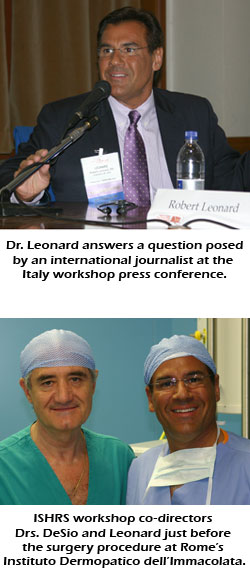|
 I just returned from a wonderful trip to Rome, Italy, where I was honored to be a part of a very special meeting. In fact, it was the first of its kind. The live hair transplant surgery meeting, titled “Made in Italy: Hair Restoration Live Surgery Workshop,” brought international physicians and surgeons, surgical assistants and nurses together to learn about the latest practices and hair restoration techniques. The three-day meeting included live hair restoration surgeries that were viewed by attendees through a video connection, as well as panel discussions, educational sessions, medical-focused media training, and technical exhibits. I just returned from a wonderful trip to Rome, Italy, where I was honored to be a part of a very special meeting. In fact, it was the first of its kind. The live hair transplant surgery meeting, titled “Made in Italy: Hair Restoration Live Surgery Workshop,” brought international physicians and surgeons, surgical assistants and nurses together to learn about the latest practices and hair restoration techniques. The three-day meeting included live hair restoration surgeries that were viewed by attendees through a video connection, as well as panel discussions, educational sessions, medical-focused media training, and technical exhibits.
As co-director of the workshop, one of my personal highlights was being part of a team of surgeons performing a hair transplant in the largest dermatologic hospital in the world – Rome’s Instituto Dermopatico dell’Immacolata. It is a remarkable facility. We were also able to provide complimentary consultations to nearly 50 Italian men, women and children suffering from hair loss, which became a hands-on learning experience for all of the attendees. No matter where I travel, one of the things that I have observed over the years is that hair loss affects everyone the same – they simply do not like it! In doing and observing these consultations, I saw and heard the exact same worries, embarrassment, and upset that patients in New England experience.
With respect to hair restoration techniques of the future, cloning continues to garner widespread interest and was discussed during the various panel discussions. There have been exciting developments with clinical human trials of “follicular cell implantation” showing early, yet promising results. This technique involves injecting cells harvested from the donor area to the patient’s balding area. The two cell types interact, essentially stimulating the growth of a new, healthy hair follicle, which will presumably grow a hair. Because there will be virtually no control over direction or angulation of these “cloned” hairs, it is thought that follicular cell implantation will not be used as a first procedure, but instead to augment and provide more density following a hair transplant surgery. A second more, aesthetically pleasing and controlled technique would involve growing intact follicles in vitro, but we are in the very early stages of this research and are realistically 8-10 years from human trials. In any event, what was thought to be science fiction just 20 years ago will continue to provide exciting discourse in the years to come. I will continue to keep you aware of the latest developments.
Ciao!

|
